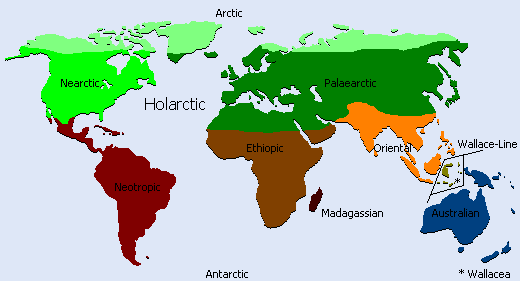

Earth can be divided in different regions distinguished by the character of their fauna. The basis of today's faunal provinces is the continental drift according to Alfred Wegener.
While the northern hemisphere's continents have separated only in geologically younger times, the southern hemisphere's continents have been separated for a longer time. Therefore their faunal provinces are more different than those of the northern hemisphere.
The northern hemisphere's faunal provinces because of their similarity are united as Holarctic (holos in Greek meaning whole). Zoogeography distinguishes Palaearctic (palaios = old) and Nearctic (neos = new) meaning the faunal provinces of the old and new world.
On the southern hemisphere the central and south American faunal province as Neotropic is placed opposite to the African faunal province of the Ethiopian, as well as the south and southeast Asian faunal province of the Oriental.
Special importance is to the small but isolated faunal province of the Madagassis meaning the characteristic fauna of Madagascar. The Wallace line between the Indonesian islands of Bali and Lombok separates the oriental faunal province from the Australian, which because of its separation for a geologically relatively long period of time possesses a special character shown for example by the special abundance of species of the ancient group of the marsupials, that have become extinct in other parts of the world long ago.
See also: Fauna Europaea on http://www.faunaeur.org.